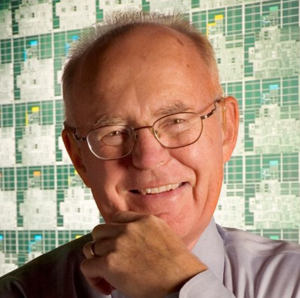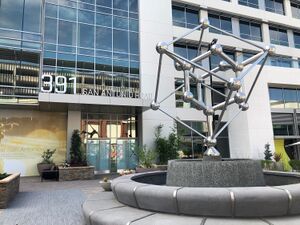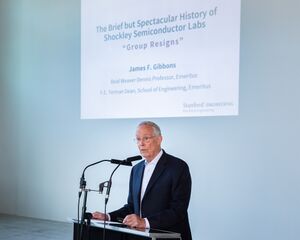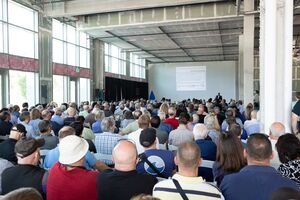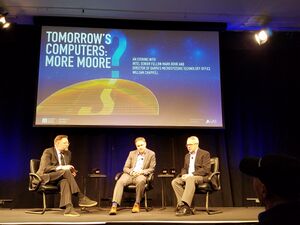Milestones:Moore's Law, 1965
- Date Dedicated
- 2018/08/15
- Dedication #
- 189
- Location
- Mountain View, CA
- IEEE Regions
- 6
- IEEE sections
- Santa Clara Valley
- Achievement date range
- 1965
Title
"Moore’s Law," 1965
Citation
Gordon E. Moore, co-founder of Fairchild and Intel, began his work in silicon microelectronics at Shockley Semiconductor Laboratory in 1956. His 1965 prediction at Fairchild Semiconductor, subsequently known as "Moore’s Law,” that the number of components on an integrated circuit will increase exponentially with time while cost per function decreases, guided the industry's contributions to advances in electronics and computing for more than fifty years.
Street address(es) and GPS coordinates of the Milestone Plaque Sites
The Village at San Antonio Center, 391 San Antonio Rd. (just off California St.), Mountain View, CA 94040 US (GPS: 37.404433, -122.110533)
Details of the physical location of the plaque
In Technology Plaza, on the northeast edge of a fountain containing a 20-foot high artwork in the form of a silicon crystal lattice; accessible from California St. just east of San Antonio Rd.
How the plaque site is protected/secured
Set into concrete that surrounds the silicon crystal artwork and fountain; site security; 24/7 access
Historical significance of the work
On April 19, 1965, Electronics magazine published an article by Gordon E. Moore, Director of the Fairchild Semiconductor Research and Development Laboratories in Palo Alto, CA that projected the growth in the complexity of integrated circuits (ICs), popularly called microchips, or computer chips, over the next ten years. Written to encourage his company’s customers to adopt the most advanced technology in their new computer designs, his prediction emerged as a self-fulfilling prophecy that informed the actions and goals of industry technologists and executives worldwide.
Under the title “Cramming more components onto integrated circuits,” Moore predicted “the development of integrated electronics for perhaps the next ten years.” [1] He plotted a graph of the maximum number of components that Fairchild technologists had been able to squeeze onto a silicon computer chip at minimum cost per component since the development of the company’s groundbreaking planar manufacturing process in 1959 until 1965. Drawing a line through just five data points he projected that “with unit cost falling as the number of components per circuit rises, by 1975 economics may dictate squeezing as many as 65,000 components on a single silicon chip.” This represented a doubling every 12 months.
At the 1975 IEEE International Electron Devices Meeting, Moore, by now co-founder responsible for R&D at Intel Corporation, noted that advances in photolithography, wafer size, process technology, and “circuit and device cleverness,” had allowed his projection to be realized. On adding subsequent products to his original handful of simple logic ICs, notably important new devices such as microprocessors and memories, Moore modified the trend and reduced his estimate of the future rate of increase in complexity to “a doubling every two years, rather than every year.” [2]
After Caltech electrical engineering professor Carver Mead dubbed this projection “Moore’s Law,’” industry technologists and managers were challenged with delivering annual breakthroughs in optics, materials science, methods of wafer processing, circuit design techniques, software, manufacturing and test equipment, and management of complex industrial operations to ensure compliance with its projections. On reviewing the status of the industry again in 1995 (at which time an Intel Pentium microprocessor held nearly 5 million transistors) Moore concluded that “The current prediction is that this is not going to stop soon.” [3] By 2010, commercial microprocessors from AMD, Intel, and other vendors comprised over 1 billion transistors representing a compound annual growth rate (CAGR) in excess of 40 percent per year.
On the 50th anniversary of Moore’s Law in 2015, Intel Corporation published a report developed by business information provider IHS that found that Moore’s Law has played a critical role in generating a minimum estimated $3 trillion in incremental GDP over the past 20 years. The report” highlighted the profound economic, technological and societal impact of Moore’s Law and how its exponential nature may have even greater implications for the future. [4]
The impact and benefits of the “Law” are evident on the economy, society and the technological universe. Improved computing performance at ever-decreasing cost enhanced existing industries and increased productivity, but also spawned whole new industries. Inexpensive, ubiquitous computing fundamentally changed the way society works, plays, communicates and lives. The foundational force of Moore’s Law has driven breakthroughs in urban design, transportation, healthcare, education, and energy production.
[1] Moore, Gordon E. “Cramming more components onto integrated circuits,” Electronics, McGraw Hill, Inc. Vol. 38, No.8 (April 19, 1965) [2] Moore, Gordon. “Progress in Digital Integrated Electronics” IEEE, IEDM Tech Digest (1975) pp.11-13. [3] Moore, Gordon. “Lithography and the Future of Moore’s Law,” Proceedings of SPIE, Vol. 2437 (May 1995) [4] Ford, Dale. “Celebrating the 50th Anniversary of Moore's Law” IHS Inc. (2015)
Features that set this work apart from similar achievements
While many technologists have offered predictions on future progress in microelectronics over the years, none have achieved the widespread and sustained impact of Moore’s Law. A significant factor behind this success has been the author’s leading role as a founder of Intel in directing the technical and financial resources and corporate strategies essential to its success. Venture capitalist Steve Jurvetson has described a figure illustrating the 1965 article as “the most important graph in human history.” [1] The San Jose Mercury News noted that "Since its inception over 50 years ago, today, Moore's Law has been a safe bet - it is the open immutable rule that drives Silicon Valley." [2] Similar trends in other areas of technology, from areal density in magnetic data storage to speed improvements in 3D printing have been described as "following Moore's Law."
[1] Jurvetson, Steve. “Transcending Moore's Law to Forge the Future,” Computer History Museum, CORE, 2015 pp. 36-39 [2] Carey, Pete. “Silicon Valley marks 50 years of Moore's Law,” San Jose Mercury News (April 19, 2015)
Significant references
Arnold Thackray, David Brock and Rachel Jones "Moore's Law", Basic Books, 2015 - all 508 pages
"Gordon Moore's Vision, Doubling Down," San Jose Mercury News, April 19, 2015, p A1 and A13
Gordon More, "Cramming more components onto integrated circuits." Electronics, Volume 38, Number 8, April 19, 1965,
"IBM Back On Track with Moore's Law," Science; July 2015, vol 349, issue 6245: p 220
Computer History Museum, CORE, 2015, Walter Isaacson, "Moore's Law @ 50," p 24-29
Computer History Museum, CORE, 2015, David Brock, "How Moore's Law Came to Be," p 30-33
Computer History Museum, CORE, 2015, Stevan Levy, "How Understanding Moore's Law Made Goggle Possible," p 34-35
Computer History Museum, CORE, 2015, Steve Jurvetson, "Transcending Moore's to Forge the Future," p 36-39
Dale Ford, "Celebrating the 50th Anniversary of Moore's Law," IHS Technology
Moore, Gordon. “Progress in Digital Integrated Electronics” IEEE, IEDM Tech Digest (1975) pp.11-13.
Moore, Gordon. “Lithography and the Future of Moore’s Law,” Proceedings of SPIE, Vol. 2437 (May 1995)
Schlender, Brent “Intel’s $10 billion gamble,” Fortune (November 11, 2002)
Moore, Gordon E. “No Exponential Is Forever: but ‘Forever’ Can Be Delayed!” Solid-State Circuits Conference, 2003. Digest of Technical Papers. ISSCC. 2003 IEEE International (February 13, 2003) pp: 20-21.
Packy, Kelly “Moore’s Law Chips Confidence” E.E. Times (2.11.15)
Hachman, Mark “Intel: Moore’s Law will continue through 7nm chips” PC World (Feb22, 2015)
"The Long Good- bye," IEEE Spectrum, April 2015 , p 29
Mack, Chris, "The Multiple Lives of Moore's Law," IEEE Spectrum, April 2015 , p 30-33
Hutcheson, Dan, "Transistors by the Numbers," IEEE Spectrum, April 2015 , p 33-37
Koomey, Joathan, and Naffzuger, Samuel, "Efficiency's Brief Reprieve," IEEE Spectrum, April 2015 , p 35
Courtland, Rachael, "When Mead Met Moore," IEEE Spectrum, April 2015 , p 37
"The Law That's Not A Law, Conversation with Gordon Moore," IEEE Spectrum, April 2015 , p 38-40
Huang, Andrew, "Moore's Law is Dying (and That Could Be Good)," IEEE Spectrum, April 2015 , p 42-45
Supporting materials
Original Article Media:Moore_1965_Electronics_Article.pdf
Moore's Law Perspective from Ted Hoff, who worked with Moore at Intel
US Representative Zoe Lofgren Resolution for this Milestone
Revised projection Media:Moore_1975_IEEE_Speech.pdf
Moore's Law at 50: https://vimeo.com/123452018
Gordon Moore: https://vimeo.com/70293585
Media:Moore's Law plot for MPUs (Linear version).jpg
Media:Moore's Law plot for MPUs (Log_Linear version).jpg

